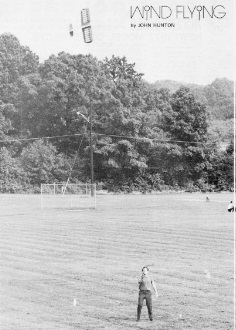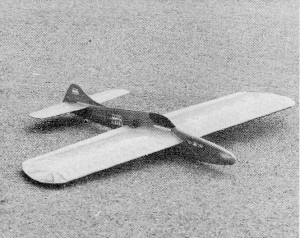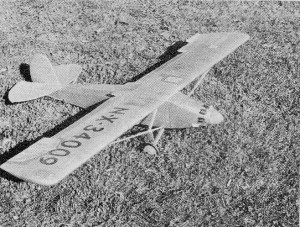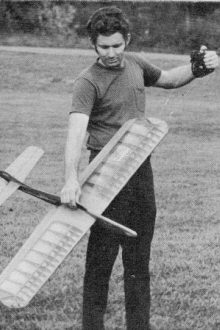|
Airplanes and Rockets website
visitor Lars B. wrote from Sweden requesting that I scan this "Wind Flying" article
from the September 1972 edition of American Aircraft Modeler magazine.
It describes a method for replacing engines and motors with human power for preforming
some pretty impressive C/L aerobatics on windy days. Basically, you drag the model
airplane around on its control lines, which often required not just turning in a
circle while standing in one place, but walking around a small circle in order to
get more speed. If there is any wind, you need to put extra effort into the pulling
when moving into the wind. I can remember doing this as a teenager, only I did it
with the engine in place but not running - usually because I could not afford to
buy enough fuel to fly as often as preferred.
Wind Flying
 By John Hunton By John Hunton
Three inside loops followed by some lazy eights, a couple of wingovers, the wires
are whistling now. There is a strong, steady breeze at your back. An inside loop
followed by half a loop. Down elevator, the outside loop portion,. up elevator.
The plane rounds out six feet off the ground and is moving fast enough to begin
another vertical eight, but you have been flying for half an hour now and you should
be getting back home. You bring the plane down to six inches off the ground and
let it kill off speed. It touches the ground once, but so what. No prop to break.
The plane finally stalls and lands. You wind up the lines, pick up your stunt model
and leave. There is nothing else to carry. No tool box, no oil to wipe off, no prop
to break, no muffler, no noise - just plain fun.
Earlier that day you had awakened to the sound of the wind whistling. Other modelers
had turned over and gone back to sleep. They wouldn't fly in this wind, but this
is exactly the type of day you have been waiting for - to go wind flying. Wind flying
is a ball. If you cannot fly inverted, your repertoire will be wingovers and a limited
number of loops. If you can fly inverted, the world of silent flights is yours.
For years I have seen experienced stunt fliers finish a flight with a few dead-stick
loops. At a contest in Frederick, Maryland, a storm hit and the high winds cancelled
flying temporarily. My brother Hugh took his stunt job up with a short tank and
began dead-sticking in the high wind-he stunted until the wind tapered off. Later,
I got out an old fuel-soaked stunt job, filled the nose with modeling clay and found
that the model would fly even in a modest wind, evidently because of reduced drag
by having no motor or propeller. After trying several different models, I have the
following suggestions as to the type of model you use.

Author's modified and cleaned-up Sig "Banshee." Lead in nose
compartment is smoothed in with clay.

Spirit of St. Louis stunter is an unlikely subject for aerobatics
and an even more unlikely subject for powerless flight, but it does very well. Note
many patches, fuel-proof dope is not necessary.
A ringmaster type model will perform fairly well, but it takes a strong wind
which is not always available. Refinements can make it possible to stunt in a light
breeze. Select an old stunt job or build a new one. Remove the motor and add an
equivalent amount of nose weight. Use a model with wing flaps - flaps make wings
much more efficient in turns. Reduce drag as much as possible. Remove landing gear
and add skids. Reduce rudder area to half of normal to minimize weathervaning.
Flying technique is very important.
Fly smoothly. Jerky motions or over-controlling add drag. Wait for a good windy
day. If you have a U-Reely, you can operate alone. You can let out an amount of
line appropriate for the amount of wind. If you do not have a U-Reely, have a strong
friend run as fast as he can and throw as hard as he can with the point of release
on the downwind side. Keep the plane down low and whip. After 11 couple of laps
of whip-ping, the plane should have good speed up. Now you can relax.
The basic speed-building maneuver is a smooth, open wingover with the high point
into the wind and the low point downwind. A few wingovers will have the model zinging
along and you will be ready to proceed to other stunts. Smooth, wide inside loops
also build speed. Another basic speed building maneuver is the lazy eight.

With a Jim Walker U-Reeley handle each flight starts from hand slowly letting
the lines all the way out. Model can be recovered in flight too-just reverse the
launching procedure.
From the above basic maneuvers the rest is up to you. Almost any maneuver in
the AMA stunt routine can be done with a good plane in enough wind.
Although wind flying began in a storm, I do not recommend flying in an electrical
storm. Static electricity can zap you good, and who wants to become a conductor
for lightning!
So go ahead. Dig out that old stunt job or build a new one. Then wait for a windy
day. Now that is a switch, isn't it?
Posted August 12, 2014
|



